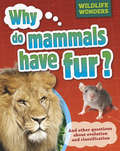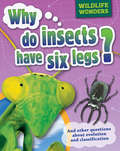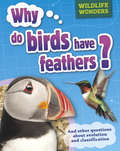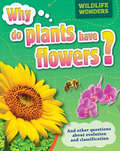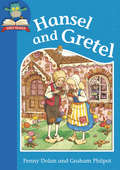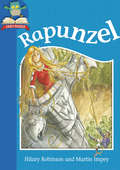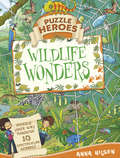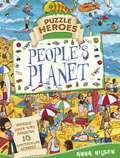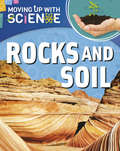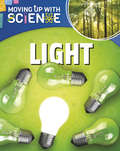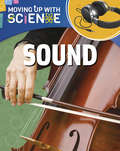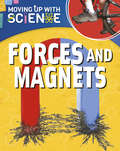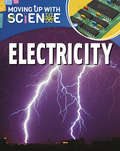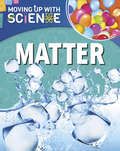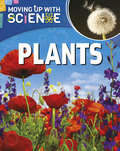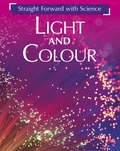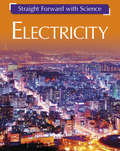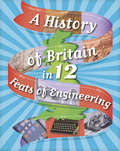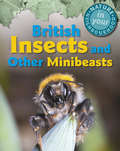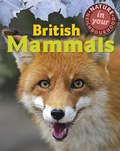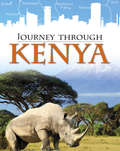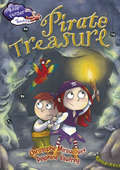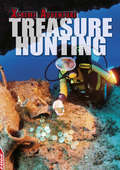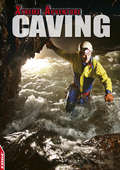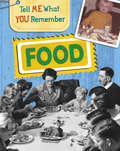- Table View
- List View
Why Do Mammals Have Fur?: And Other Questions About Evolution And Classification (Wildlife Wonders #4)
by Pat JacobsAn original new science series which explores the key characteristics that divide the main animal and plant groups, and looks at how these characteristics have evolved over time. The information is supported by examples that highlight the quirky and amazing qualities of the natural world, as well as revealing the dazzling variety within each group.Why Do Mammals Have Fur? looks at the defining features of mammals, such as being warm-blooded, having hair and feeding their young, and explores how mammals have evolved and adapted over time. Mammal life cycles, behaviour and habitats all also feature.
Why Do Insects Have Six Legs?: And Other Questions About Evolution And Classification (Wildlife Wonders #1)
by Pat JacobsAn original new science series which explores the key characteristics that divide the main animal and plant groups, and looks at how these characteristics have evolved over time. The information is supported by examples that highlight the quirky and amazing qualities of the natural world, as well as revealing the dazzling variety within each group.Why do Insects Have Six Legs? looks at the features that make insects so unique. It describes how they have evolved over time, and looks at how their movement developed. Insect senses, behaviour and habitats all also feature.
Why Do Birds Have Feathers?: And Other Questions About Evolution And Classification (Wildlife Wonders #2)
by Pat JacobsAn original new science series which explores the key characteristics that divide the main animal and plant groups, and looks at how these characteristics have evolved over time. The information is supported by examples that highlight the quirky and amazing qualities of the natural world, as well as revealing the dazzling variety within each group.Why do Birds have Feathers? looks at the features that make birds so unique. It describes how birds evolved from small dinosaurs, and looks at how feathers and flight developed. Bird senses, behaviour, habitats and flightless birds all also feature.
Why Do Plants Have Flowers?: And Other Questions About Evolution And Classification (Wildlife Wonders #3)
by Pat JacobsAn original new science series which explores the key characteristics that divide the main animal and plant groups, and looks at how these characteristics have evolved over time. The information is supported by examples that highlight the quirky and amazing qualities of the natural world, as well as revealing the dazzling variety within each group.Why do Plants Have Flowers? looks at the features that make plants so unique. It describes how they have evolved over time, and looks at how flowers, seeds and pollintation developed. Behaviour, habitats and adaptation all also feature.
Hansel and Gretel (Must Know Stories: Level 1)
by Penny DolanHansel and Gretel saw a pretty cottage, covered in gingerbread and sweets...A beautifully illustrated retelling of this favourite traditional story. Join Hansel and Gretel in their attempts to escape the wicked old witch.Must Know Stories includes favourite tales, celebrating the diversity of our literary heritage. Level 1 stories are told in under 500 words, for children to read independently.
Rapunzel: Level 1: Rapunzel (Must Know Stories: Level 1)
by Hilary Robinson"Rapunzel, Rapunzel, let down your hair!"In this favourite fairy tale, the beautiful girl is locked in a tower by a jealous witch. She can only be reached by the witch climbing her long hair. Then, one day, a prince comes riding by. Will the pair ever escape the clutches of the witch?Must Know Stories includes favourite tales, celebrating the diversity of our literary heritage. Level 1 stories are told in under 500 words, for children to read independently.
Wildlife Wonders (Puzzle Heroes #8)
by Anna NilsenDive into this exciting book full of amazing creatures all around the world and help save Mum from evil poachers by completing the puzzles.Puzzle Heroes is an interactive series of very fun, visually-led books containing an adventure or challenge on every page. There are plenty of search-and-find elements in the style of Where's Wally?, combined with topics of educational value, where fun facts help with the challenges. This gives plenty of opportunity to use the book as an extra learning tool - but ultimately the quests are fantastic fun, engrossing readers to the extent that they won't realise they are learning.
People's Planet (Puzzle Heroes #7)
by Anna NilsenAre you ready to journey around the planet to find Dad, a journalist who has been kidnapped? Help Zak and Leah solve the puzzles and save him!Battle your way through ten scenes and solve the puzzles, from brain-busting maths conundrums to spot-the-difference. Prepare to take a tour through a Machu Picchu maze, go hunting with the Inuits, discover the tallest skyscrapers in the world, dig into a gold mine and explore the Great Wall of China. You'll discover lots about the way people live, work and play around the world. There are search and find challenges on every page.Puzzle Heroes is an interactive series of very fun, visually-led books containing an adventure or challenge on every page. There are plenty of search-and-find elements in the style of Where's Wally?, combined with topics of educational value, where fun facts help with the challenges. This gives plenty of opportunity to use the book as an extra learning tool - but ultimately the quests are fantastic fun, engrossing readers to the extent that they won't realise they are learning.
Rocks and Soil (Moving up with Science #1)
by Peter RileyFind out all about the science in the world around us with Moving Up with Science. Written to support the National Curriculum at Key Stage 2, each title explores key scientific topics through a combination of concise information and fun experiments. Moving Up with Science: Rocks and Soil looks at Earth and the rocks that make it up, from its fiery core and volcanoes to limestone cliffs and fossils. It also explores how rocks form and reform over time, and how they change the world around us.
Light (Moving up with Science #2)
by Peter RileyFind out all about the science in the world around us with Moving Up with Science. Written to support the National Curriculum at Key Stage 2, each title explores key scientific topics through a combination of concise information and fun experiments. Moving Up with Science: Light looks at what light is, where it comes from and how essential it is to life on Earth.
Sound (Moving up with Science #3)
by Peter RileyFind out all about the science in the world around us with Moving Up with Science. Written to support the National Curriculum at Key Stage 2, each title explores key scientific topics through a combination of concise information and fun experiments. Moving Up with Science: Sound looks at how sound moves; how fast sound travels; and what happens when sound waves reach our ears. Discover how sounds can be high, low, loud or quiet.
Forces and Magnets (Moving up with Science #4)
by Peter RileyFind out all about the science in the world around us with Moving Up with Science. Written to support the National Curriculum at Key Stage 2, each title explores key scientific topics through a combination of concise information and fun experiments. Moving Up With Science: Forces and Magnets takes you on a journey of scientific discovery. Find out how we use forces everyday; which force pulls objects down holes and why Earth acts like a huge magnet. Explore which materials are magnetic and discover how to test them.
Electricity (Moving up with Science #5)
by Peter RileyFind out all about the science in the world around us with Moving Up with Science. Written to support the National Curriculum at Key Stage 2, each title explores key scientific topics through a combination of concise information and fun experiments. Moving Up with Science: Electricity reveals how electricity was discovered; what is inside a battery; and howto make your own series circuit. Explore the many uses of electricity and discover how to make your own buzzing robot.
Matter (Moving up with Science #6)
by Peter RileyFind out all about the science in the world around us with Moving Up with Science. Written to support the National Curriculum at Key Stage 2, each title explores key scientific topics through a combination of concise information and fun experiments. Moving Up with Science: Matter describes how and why water evaporates; how ice melts and why we can't normally see gases. Explore the water cycle and discover how it affects our weather.
Plants: Ways Into Science (Moving up with Science #7)
by Peter RileyFind out all about the science in the world around us with Moving Up with Science. Written to support the National Curriculum at Key Stage 2, each title explores key scientific topics through a combination of concise information and fun experiments. Moving Up with Science: Plants explains why flowers have colourful petals; how leaves make food for plants; and how water moves inside roots and stems. Explore different types of flower and discover what happens when seeds are kept in the dark.
Light and Colour: Light And Colour (Straight Forward with Science #1)
by Peter RileyStraight Forward with Science offers a straightforward, but fun, approach to key science learning. Each book explores basic scientific principles and shows them in action, while simple activities and experiments bring the science to life. Light and Colour looks at what light is, where it comes from and how it reaches us here on Earth. Light rays, shadows, mirrors and colour are all also explored.
Electricity (Straight Forward with Science #6)
by Peter RileyStraight Forward with Science offers a straightforward, but fun, approach to key science learning. Each book explores basic scientific principles and shows them in action, while simple activities and experiments bring the science to life. Electricity looks at what is electricity is, how it is generated and how it makes the world around us work, both at home and in nature. Electrical circuits, electromagnets and motors are all also explored.
A History of Britain in 12... Feats of Engineering (A History of Britain in 12...)
by Paul RockettBritain has been home to world-leading engineers, inventors, architects and designers who have changed the way Britain and the world works. In this book discover some key feats of engineering that have taken place in Britain or have been created by British innovators since prehistoric times until today. Find out have all played a part in shaping the history of Britain, and what they tell us about the different periods of our history.The book is part of 'A history of Britain in 12 ...', a series which examines 12 items that are key to British history from the Stone Age to present day. The series helps students understand chronology and the idea of continuity and change. By focusing on different objects, it also encourages the reader to understand how our knowledge of the past is constructed from a range of sources and to gain knowledge of the methods of historical enquiry.
British Insects and other Minibeasts (Nature in Your Neighbourhood #1)
by Clare CollinsonThere are more insects and other minibeasts in British neighbourhoods than any other kind of animal. Whether you are at home, walking down the street, in a meadow or by a river, there's plenty of minibeasts to discover! In this book discover a range of minibeasts from bees, butterflies and bugs to worm and woodlice. It is full of great nature-spotting tips and includes information about the classification of insects.The book is part of the 'Nature in your neighbourhood' series - find out all about the plants and animals that live all around you!
British Mammals (Nature in Your Neighbourhood #2)
by Clare CollinsonWherever you live in Britain, you will be amazed at how much mammal life there is right on your doorstep. Even in the busiest cities, there are small rodents, such as this squirrel, and larger predators, such as foxes. In this book find out all about the mammals that live in British cities, the coutryside and in our waterways. Discover the best ways to spot them and learn about the classification of mammals.The book is part of the 'Nature in your neighbourhood' series - find out all about the plants and animals that live all around you!
Kenya: Kenya Journey Through: Kenya (Journey Through #10)
by Liz GogerlyJourney Through offers young readers the chance to take a trip through exciting world countries using different modes of transport, from train and car to bicycle and private jet. Along the way the traveller visits highlighted places both well known and less known, and learns lots of exciting facts about history, language, culture and much more.Journey Through Kenya offers a look at the geography landscape, culture and people of this country in East Africa. Explore the exciting buzz of Nairobi, the beautiful national parks and stunning lake Victoria, sample local delicacies and explore the Masai Mara where you might even spot the 'big five' on safari in this colourful and diverse part of the continent of Africa.
Pirate Treasure (Race Further with Reading #8)
by Christophe MiraucourtMelinda and her brother Ricky discover the whereabouts of some secret treasure! However, the sinister Captain Crook is after the treasure too and kidnaps the children to Skeleton Island...they must find the treasure or await their doom!Race Further with Reading is the perfect tool to build reading confidence with illustrated stories in manageable bite-size chapters, following on a level from the Race Ahead with Reading series with stories of 2,000 words.
Treasure Hunting (EDGE: Xtreme Adventure #1)
by S.L. HamiltonKick excitement into high gear with this extreme title! Short, easy-to-read text pairs with full-colour, action-packed photos to introduce young adventurers to treasure hunting. Readers will learn about the tools and equipment used in hunting treasure, as well as dangers and safety tips. They are introduced to different types of treasure, such as coins, jewellery, silver bars, gold, glass and bottles, and artifacts. Common places to find treasure are discussed, such as beaches and parks. Extreme facts supplement the text, leaving future treasure hunters excited for an extreme adventure!
Caving (EDGE: Xtreme Adventure #2)
by S.L. HamiltonKick excitement into high gear with this extreme title! Short, easy-to-read text pairs with full-colour, action-packed photos to introduce extreme sports fans to caving. Readers will learn about the tools and equipment used in exploring caves, as well as dangers and safety tips. They are introduced to types of caves including limestone caves, sandstone caves, lava caves, sea caves, ice and glacier caves, sinkholes, and mud and boulder caves. Cave formations such as stalactites and stalagmites are also introduced. Extreme facts supplement the text, leaving future caving enthusiasts excited for an extreme adventure!
Food (Tell Me What You Remember #3)
by Sarah RidleyEveryone has memories of the food they ate they had when they were growing up. This book gives young children access to people's memories alongside photographs to help them build up a picture of the past. From family meals to wartime rationing young children can explore what has changed and what remains the same.The book is part of the 'Tell me what you remember' series, which explores changes in living memory through photographs and memories. It is a perfect teaching tool for KS1 or for children up to age 7.
